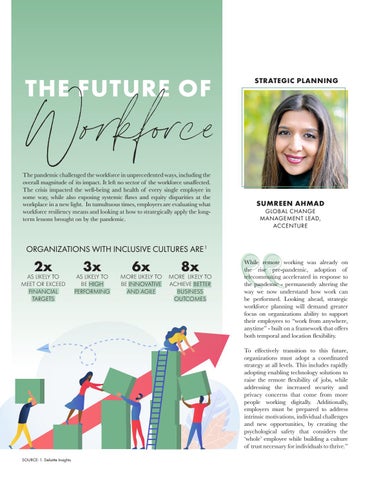Workforce THE FUTURE OF
The pandemic challenged the workforce in unprecedented ways, including the overall magnitude of its impact. It left no sector of the workforce unaffected. The crisis impacted the well-being and health of every single employee in some way, while also exposing systemic flaws and equity disparities at the workplace in a new light. In tumultuous times, employers are evaluating what workforce resiliency means and looking at how to strategically apply the longterm lessons brought on by the pandemic.
STRATEGIC PLANNING
SUMREEN AHMAD GLOBAL CHANGE MANAGEMENT LEAD, ACCENTURE
ORGANIZATIONS WITH INCLUSIVE CULTURES ARE 1
2x AS LIKELY TO
3x AS LIKELY TO
6x MORE LIKELY TO
8x MORE LIKELY TO
MEET OR EXCEED FINANCIAL TARGETS
BE HIGH PERFORMING
BE INNOVATIVE AND AGILE
ACHIEVE BETTER BUSINESS OUTCOMES
While remote working was already on the rise pre-pandemic, adoption of telecommuting accelerated in response to the pandemic - permanently altering the way we now understand how work can be performed. Looking ahead, strategic workforce planning will demand greater focus on organizations ability to support their employees to “work from anywhere, anytime” - built on a framework that offers both temporal and location flexibility. To effectively transition to this future, organizations must adopt a coordinated strategy at all levels. This includes rapidly adopting enabling technology solutions to raise the remote flexibility of jobs, while addressing the increased security and privacy concerns that come from more people working digitally. Additionally, employers must be prepared to address intrinsic motivations, individual challenges and new opportunities, by creating the psychological safety that considers the ‘whole’ employee while building a culture of trust necessary for individuals to thrive.”
SOURCE: 1. Deloitte Insights
